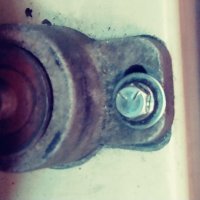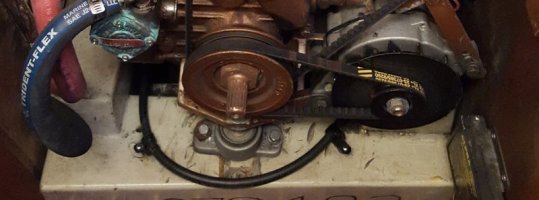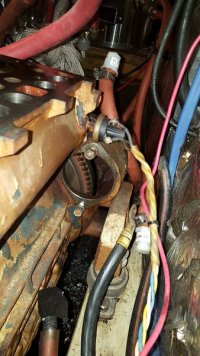5432 engine mount
Neil,
I had the same problem with my engine mount lag bolt. The port side lag was stripped out and I could not get a larger lag in due to the constraints of the engine mount and its bored opening. I poked and prodded and found there was no bottom to the bed log. I could stick a coat hanger down through the hole and it would hit the bottom of the hull.I did NOT want to have to remove the engine nor detach the mount.I decided on a few options and began exploring feasibility of same.
Option 1: was to drill out the engine mount hole to accept a larger diameter lag.
Decision: I did not think that after drilling there would be enough metal left in the mount between the wall of the newly drilled hole and the outside of the mount. Not enough" meat". I also did not like the idea of simply putting in a larger lag into wood ( of unknown species) that has already been compromised. I also could not figure out how to get a drill into position to do the task. The area is too confining.
Option 2: Try to figure out a way to temporarily block the bottom of the hole with an epoxy coated material to form a plug and let it dry. After curing I could fill the hole with epoxy and then insert the old lag while still wet I would have a coating of PAM on the lag so it could be removed. After the filler dried I could then remove the lag, add a washer and re-insert the lag and tighten it up. I thought that this would be the preferred approach.
Decision: I tried several times to insert different materials into the hole but they always fell through. I tried fiberglass tape saturated in epoxy and pushed it down slightly but it always fell through, I tried a piece of sponge, fell through. I thought of using a spray foam expanding insulation but was not confident it wouldn't also fall through. I surmised that the bottom of the hole must have been flared due to the deterioration of the wood.
Option 3: Insert a dowel soaked with epoxy and drive it into the hole? It sounded like a good idea but I had already decided that I could not get a drill into the area.
Decision: I really liked this idea but kept wondering how I could drill the dowel after it was in. Then I thought what if I could drill the dowel BEFORE I put it in? How does one do that? I gave it a lot of thought and came up with this. While my home is over two hours from the boat and I did not have the exact diameter of the hole, I bought 4 different sizes of oak dowels ( thinking one of them had to be the correct size). I cut 4" off of each dowel to be used. I then mounted a 4x6 block of wood to the table of my overhead drill press so the 6" side was vertical. I will use the 5/8" diameter dowel as an example for the explanation. I drilled a 3-3/4" deep x 5/8" hole into the block. I then used pushed in the dowel. I then secured the dowel from spinning using a drywall screw being careful to only just touch the exterior of the dowel and not penetrate it. I then switched to a 3/8" bit and slowly lowered it down onto the dowel. The result was a nearly perfectly drilled hole in the dowel.
Application: I took my assorted drilled out dowels to the boat, decided which one fit best and scored the exterior of the dowel so as to provide an irregular surface for bonding. I then cut up some fiberglass cloth into tiny shreds and mixed them with epoxy. I also cut a thin strip of epoxy cloth (3/8" wide x 6" long and soaked it with epoxy. I laid the cloth across the lag bolt hole, coated the exterior of the dowel with the thickened mixture, set the dowel in place and began to drive it home using very short raps with a short handled 2lb. lump hammer. When I could not get it down any further I took a wrecking bar and placed it on the dowel and began hitting on it, the bar (offset) about 5" away from the dowel. This allowed me to set the dowel even deeper. I let the epoxy set for 24 hours, said a prayer to all who would listen and set the original lag bolt in the hole and ratcheted it down. I cranked down on it pretty hard and it did not spin. I then cranked down as hard as I could and it held without spinning. I have had the fix in place now for about 100 hours of engine running time and when I check the bolt with a socket wrench it is still secure. I know one day I will have to pull the engine and replace all of the mounts, but am very happy I did not have to do it just for the sake of a single lag bolt.
I hope this helps you with your lag issuesand provides you with another possible solution to consider. GOOD LUCK. As I like to say the thinking usually takes much longer than the doing.



